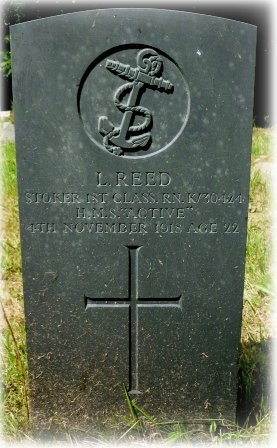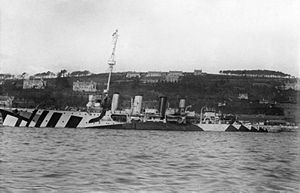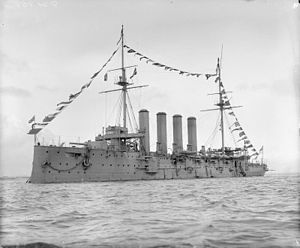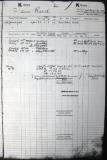Stoker Lewis Reed K/30424 HMS Active died at home in Middlewood on 4 November 1918 having suffered from erysipelas and meningitis.
 Instantly recognisable, austere and profoundly moving, official war grave headstones are to be found in cemeteries large and small throughout the British Isles as well as in historic theatres of war all over the world. Sadly, some are more recent, but many pay tribute to those who lost their lives in World War One. St Torney's church in North Hill village has four formally designated war graves, but only one with a Commonwealth War Graves Commission headstone. This marks the last resting place of Lewis Reed who was born on 6th September 1896 in Middlewood and who died there on 4th November 1918. He was the son of Philip and Emma Reed. Instantly recognisable, austere and profoundly moving, official war grave headstones are to be found in cemeteries large and small throughout the British Isles as well as in historic theatres of war all over the world. Sadly, some are more recent, but many pay tribute to those who lost their lives in World War One. St Torney's church in North Hill village has four formally designated war graves, but only one with a Commonwealth War Graves Commission headstone. This marks the last resting place of Lewis Reed who was born on 6th September 1896 in Middlewood and who died there on 4th November 1918. He was the son of Philip and Emma Reed.
In 1871 three year old Philip Reed was living at Trebartha Barton with his family. His father, Thomas, had been born at Tremaine and his mother, Emma, at Egloskerry. His two elder siblings, John and Mary, were both born at North Petherwin. Thomas was a farm labourer, and it was common for such families to move around as work became available. By the time of the 1881 census the family were living in St Neot, and Philip had two further siblings: Annie who was also born in North Hill, and young Thomas, who had born five years previously in St Neot. Ten years later Philip was working and living at Kingbear, North Hill, on the farm of Thomas Budge.
In the summer of 1892 Philip Reed married locally to Emma Doidge (a direct descendant of the Spoure family who were once Lords of the Manor and lived in Trebartha Hall). By the time of the next census in 1901 Philip was working as a blacksmith's labourer and living in Middlewood. Lewis, their first-born, was four years old. In 1911 the family still lived at Middlewood and had a further son, Percy, five years younger than his brother. Lewis is recorded as earning his living as a gardener. The census information also indicates that two other children had been born, and lost.
 HMS Vivid (pictured here and later renamed HMS Drake) was the shore base in Plymouth where, historically, the majority of young men from the West Country joined the Royal Navy, and so it was for Lewis Reed. He joined up on 17th January 1916. He was aged nineteen and described himself as a farm labourer. He then began training as a ship's stoker. He joined his first ship, HMS Sutlej, in June of that year having completed six months' training. The Sutlej, shown below, was a Cressy-class armoured cruiser, already out of date at the outbreak of war. Whilst Lewis Reed was aboard, the Sutlej spent much of her time in the Azores and off the west coast of Africa. HMS Vivid (pictured here and later renamed HMS Drake) was the shore base in Plymouth where, historically, the majority of young men from the West Country joined the Royal Navy, and so it was for Lewis Reed. He joined up on 17th January 1916. He was aged nineteen and described himself as a farm labourer. He then began training as a ship's stoker. He joined his first ship, HMS Sutlej, in June of that year having completed six months' training. The Sutlej, shown below, was a Cressy-class armoured cruiser, already out of date at the outbreak of war. Whilst Lewis Reed was aboard, the Sutlej spent much of her time in the Azores and off the west coast of Africa.
 In January 1917, Lewis was promoted to Stoker I. The Sutlej returned to Devonport in the spring and her crew were paid off on 4th May. Stoker Reed returned to the Vivid and joined the crew of HMS Active on 6th July 1917. The Active was deployed to the Mediterranean. Lewis Reed's naval record ends on 3rd November 1918, with the notation that he had died at home in Middlewood. In January 1917, Lewis was promoted to Stoker I. The Sutlej returned to Devonport in the spring and her crew were paid off on 4th May. Stoker Reed returned to the Vivid and joined the crew of HMS Active on 6th July 1917. The Active was deployed to the Mediterranean. Lewis Reed's naval record ends on 3rd November 1918, with the notation that he had died at home in Middlewood.
At some point in his short naval career, he had contracted the disease erysipelas, also known as St Anthony's fire. Fatally, he also caught meningitis. The latter illness broke out fairly regularly in various forces throughout World War One, and its spread was exacerbated by crowded living quarters on board ship, in barracks and even in overburdened hospitals.  Erysipelas was disfiguring, painful and could travel through the bloodstream. It is not clear at what point Lewis was sent home from his duties, but he certainly returned to his family with little hope of survival. This fair-haired, blue-eyed boy was the third of Philip and Emma Reed's children to predecease them. Erysipelas was disfiguring, painful and could travel through the bloodstream. It is not clear at what point Lewis was sent home from his duties, but he certainly returned to his family with little hope of survival. This fair-haired, blue-eyed boy was the third of Philip and Emma Reed's children to predecease them.
Lewis Reed encountered, fought and was felled by a deadly foe in the service of his country and his gravestone recognizes his sacrifice. His service record can be seen by clicking on the image to the left. |


